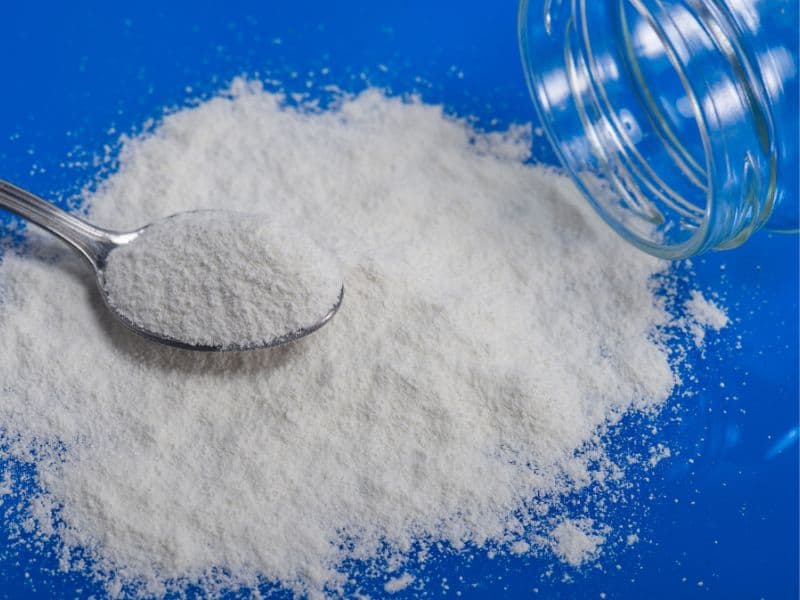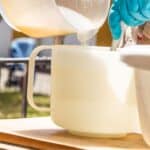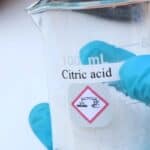Finding the ideal temperature for lye and oil to be mixed is a crucial aspect of crafting high-quality, homemade soap. In this guide, we’ll dive into the temperature range for mixing lye and oil, how to prepare these ingredients, and tips for troubleshooting temperature-related issues.
The ideal temperature for mixing lye and oil in soap making is between 100°F and 115°F (38°C to 46°C), ensuring proper blending and a consistent reaction for high-quality homemade soap. It can also help you avoid common soap making problems such as separation.
When you mix the lye and water it will heat by itself, you will have to wait for it to cool before you continue mixing the oil. In addition, If the lye water and oil are not warm enough, the mixture might not blend well, causing the soap to separate or have a lumpy texture.
Alternatively, if the oil and lye water is too hot when mixed, the soap can thicken too quickly, making it difficult to work with and possibly resulting in a brittle or crumbly final product.
Keeping the right temperature for lye and oil is very important for making great soap. By watching the temperatures closely, you can make sure the lye and oil mix together well.
This helps you avoid problems like the soap separating or becoming too thick too fast.
Let’s take a closer look at the details when it comes to mixing lye water and oil.
Ideal Temperature for Mixing Lye and Oil
The optimal temperature range for combining lye and water is between 100°F and 115°F (38°C and 46°C). It is important to stay within this range to ensure that the lye dissolves completely and reacts consistently with the oils during soap making.
At the very least the water and lye mixture should be within 10°F of the oils you are using.
Similarly, for the oils, it is recommended to maintain a temperature range of 100°F to 115°F (38°C and 46°C) to ensure that they are completely melted and in a liquid state, which allows for a smooth blending with the lye solution, resulting in fewer issues.
This slightly elevated temperature is recommended to make sure that all of the oils being used in the recipe are completely melted, and the water and lye temperature is to prevent rapid cooling of the oils when they come in contact with each other.
Tips to ensure mixing success
- Use a reliable, calibrated thermometer to accurately check the temperatures of both the lye solution and oils.
- Be patient during the cooling process; rushing might cause uneven temperatures, leading to an inconsistent final product.
- Monitor the temperatures closely, and avoid mixing the lye solution and oils if their temperatures differ by more than 10°F.
Preparing Lye Water Solution
Safety measures
- Always wear proper protective gear, such as gloves, goggles, and long sleeves, to minimize the risk of skin and eye irritation.
- Work in a well-ventilated area to avoid inhaling any harmful fumes produced when mixing lye and water.
- Keep a bottle of vinegar within reach to quickly neutralize any lye spills or splashes on surfaces.
Measuring lye and water
- Use a digital scale with high precision for accurate measurements of both lye and water.
- Measure water and lye in separate, heat-resistant containers to avoid any accidental reactions.
- Follow your specific soap recipe’s recommended lye-to-water ratio to ensure a successful outcome.
Mixing and cooling process
- Gradually pour the lye into the water (never the other way around) while stirring gently to avoid creating any lye pockets.
- The mixture will heat up significantly, becoming cloudy and emitting fumes. Continue stirring until the lye is fully dissolved.
- Allow the lye solution to cool down to the ideal temperature range of 100°F to 115°F before combining it with the oils.
Preparing Oils
Choosing the right oils
- Evaluate the properties of various oils such as moisturizing ability, lather production, and hardness to create a balanced soap with desired characteristics.
- Popular oils include coconut oil (for lather and hardness), olive oil (for moisturizing), palm oil (for hardness and stable lather), and sunflower oil (for conditioning). Each oil contributes distinct benefits to your soap.
- Research trusted soap recipes or utilize a soap calculator to develop a custom blend of oils that meets your preferences and goals.
Melting and cooling process
- Accurately weigh each oil using a precise digital scale and combine them in a large, heat-resistant container or pot.
- For solid oils, such as coconut or palm oil, melt them gently over low heat using a double boiler, or in short intervals in a microwave to prevent scorching or burning.
- Allow the oil mixture to cool down to the target temperature range of 100°F to 115°F before incorporating it with the lye solution.
Combining Lye Water and Oil Mixtures
Checking temperatures
- Employ a dependable thermometer to confirm that both the lye solution and oils have reached the optimal temperature range of 100°F to 115°F.
- Ensure that the temperature difference between the lye solution and oils is no greater than 10°F to avoid any complications during the blending process.
Stirring techniques
- Gradually pour the lye solution into the oil mixture, constantly stirring to integrate the two components uniformly.
- Utilize a silicone spatula or an immersion blender to combine the lye solution and oils effectively, achieving a consistent trace or emulsification.
- Switch between hand stirring and using the immersion blender to maintain better control over the mixing process, preventing over-mixing or aeration.
Trace stage in soap making
- “Trace” is the term used to describe the stage when the lye solution and oils have completely emulsified, resulting in a pudding-like texture.
- Light trace: At this stage, the soap mixture leaves a delicate trace on the surface when drizzling, making it suitable for executing intricate designs or patterns.
- Medium to thick trace: The mixture maintains its shape, which is ideal for creating simpler designs, crafting layers, and achieving textured tops in your soap.
Troubleshooting Temperature Issues
Overheated lye or oil
Overheating can result in problems such as seizing (soap mixture solidifies quickly), accelerated trace, or an inconsistent final product. Regularly check temperatures during the preparation stage.
If the lye solution becomes too hot, place the container in an ice bath or cold water to cool it down gradually. Gently stir the solution to promote even cooling and prevent lye concentration pockets.
For overheated oils, remove the container from the heat source and allow it to cool at room temperature. Placing hot oils in cold water may cause sudden solidification, which can complicate the soap-making process.
Uneven temperatures
Discrepancies in temperature between the lye solution and oils can cause difficulties in achieving a proper trace, resulting in a separated or uneven final product during the soap-making process.
If the lye solution cools faster than the oils, place the container in a warm water bath, being cautious not to let any water enter the solution. Gently stir until the temperature matches that of the oils.
If the oils cool too quickly, use a double boiler or microwave them in short intervals, stirring between each interval to distribute heat evenly and gently warm the oils to the desired temperature range.
Cooling solutions
Exercise patience during the cooling process. Allow both the lye solution and oils to cool naturally at room temperature while keeping a close eye on their progress.
To expedite the cooling process, use shallow, wide containers made of materials with high thermal conductivity, like stainless steel or glass. This allows heat to dissipate more quickly, resulting in faster cooling.
Create a stable room environment by maintaining consistent room temperature, and avoid drafts or direct sunlight, as these factors can cause fluctuations in the cooling rate of your lye solution and oils, leading to potential issues in the soap-making process.
Safety Tips For Making Lye Water
When working with lye and water in soap making, safety should always be a top priority. Lye, also known as sodium hydroxide, is a powerful and caustic substance that can cause serious harm if not handled correctly.
To safely mix lye and water, follow these guidelines:
- Wear safety gear: Protect yourself by wearing gloves, goggles, and long sleeves to prevent lye from coming into contact with your skin or eyes.
- Use proper ventilation: Work in a well-ventilated area, like outdoors or near an open window, to avoid breathing in harmful fumes.
- Correct mixing order: Add lye to water (never water to lye) to prevent a dangerous splash. Pour the lye slowly and stir gently.
- Use appropriate containers: Mix lye and water in heat-resistant, non-reactive containers like glass or high-density polyethylene (HDPE). Avoid using metal containers, which can react with lye.
- Allow the mixture to cool: Let the lye solution cool down naturally at room temperature.
- Store lye safely: Keep lye in airtight, labeled containers, away from children and pets. Store it in a cool, dry place.
- Clean up carefully: Wear gloves while cleaning surfaces, tools, and containers used in the soap-making process to avoid contact with any leftover lye.
- Be prepared for emergencies: Have vinegar or a citric acid solution on hand to neutralize lye in case of skin contact. Rinse the affected area with water after neutralizing. If lye gets in your eyes, flush them with water and seek medical help.
Following these safety precautions can help you can minimize risks and create a secure environment for making soap. Always prioritize safety when handling lye to ensure a successful and enjoyable soap-making experience.
Frequently Asked Questions
Use a reliable thermometer to monitor the temperatures of both the lye solution and oils during the preparation process.
If the lye solution is not within the ideal temperature range, it can cause issues like separation, accelerated trace, or an inconsistent final product.
Place the container in an ice bath or cold water to cool it down gradually, stirring gently during the cooling process.
Remove the oils from the heat source and allow them to cool down naturally at room temperature.
Use a warm water bath to gently raise the temperature of the lye solution, or gently warm the oils using a double boiler or microwave, ensuring the temperatures do not differ by more than 10°F.
Common issues include soap separation, accelerated trace, and an uneven texture in the final product.
Conclusion
In conclusion, mastering the art of soap making requires a keen understanding of the ideal temperature range for mixing lye and oil. By adhering to the recommended temperature guidelines and carefully monitoring the process, you can create beautiful, high-quality homemade soaps.
Remember to be patient, practice safety measures, and learn from your experiences as you refine your soap-making skills. With time and dedication, you’ll be able to craft luxurious soaps that are perfect for your skin.






